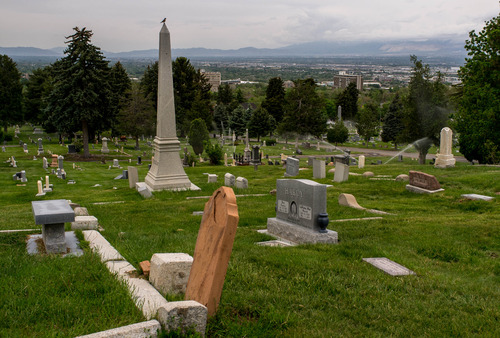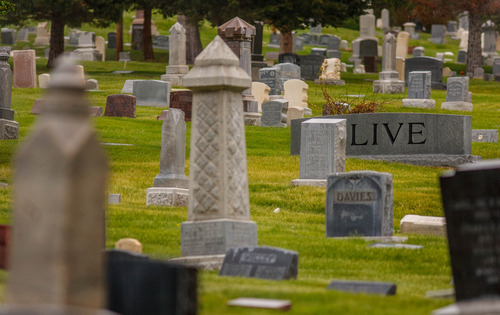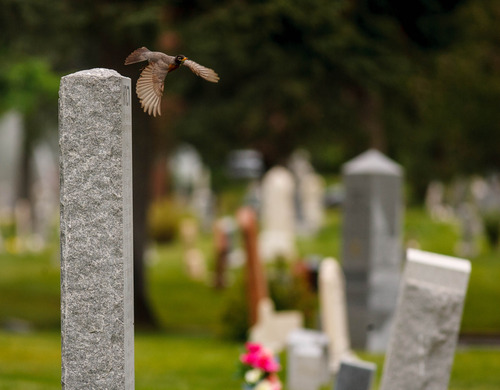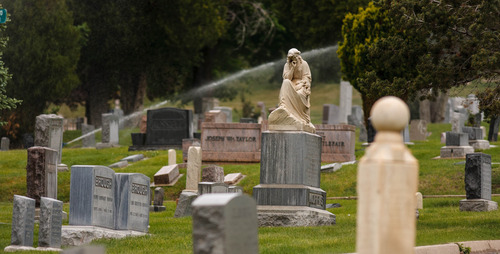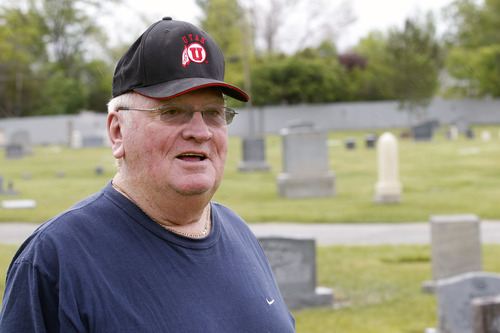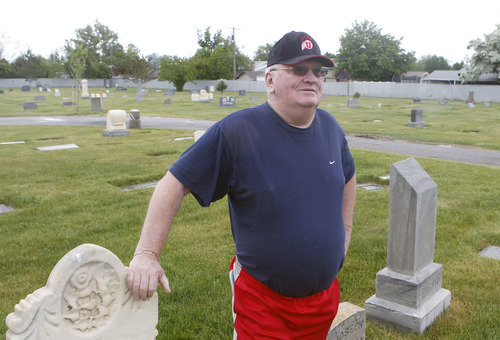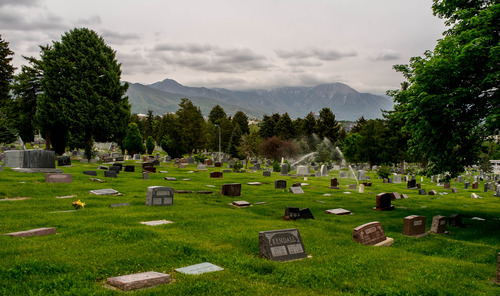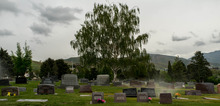This is an archived article that was published on sltrib.com in 2013, and information in the article may be outdated. It is provided only for personal research purposes and may not be reprinted.
For a group of Grantsville residents, a plan to expand the city cemetery onto the grounds of the J. Reuben Clark Historic Farm would rob the community of a piece of its agricultural heritage.
But unless the group finds a way to accommodate both the living and the dead or the city can negotiate the purchase of other nearby land, a small parcel of the farm appears likely to become burial ground.
Grantsville Mayor Brent Marshall says there are only a few groups of four grave sites together among the 100 or so remaining and residents who want to put together a larger family plot are out of luck.
"I think it would be a sad day," the mayor said, "if you had local residents who weren't able to be buried in their hometown."
Like Grantsville, cemeteries along the Wasatch Front are filling up, leading to questions of how to inter the deceased. Some suggest stopping burial plot pre-sales. Others say limiting burials to residents will help. Many try to encourage double-depth burials and cremation to conserve space, while several plan to expand their cemeteries and land holdings to accommodate more of the dead. Whatever the solution, the truth remains: People will continue to want to be buried in a place where loved ones can remember them, and their interment requires space.
—
Losing ground •Historically, houses of worship maintained graveyards on church grounds or town commons. As populations concentrated in urban centers, graveyards became more and more crowded. In response to overcrowding, cities started moving their dead to large, park-style cemeteries beginning in the 1830s.
Now the past is repeating itself as modern cemeteries fill to capacity.
Several municipal cemeteries simply have no room. Bluffdale, Draper and Sandy city cemeteries are sold out of burial plots. Others are on their last acres, with a few hundred available plots.
One city is seeking federal help. Members of Utah's congressional delegation are asking Congress to give Fruit Heights, which does not have a city or private cemetery, 100 acres of U.S. Forest Service land to accommodate its residents. Trying to alleviate their own overcrowded graveyards, neighboring cities leave Fruit Heights with few options to bury their dead.
"The need for a cemetery is becoming critical not only for Fruit Heights but also for the community at large," Fruit Heights Mayor Todd Stevenson told the U.S. House Natural Resources Subcommittee on Public Lands and Environmental Regulation in April. "The neighboring communities of Kaysville and Farmington, who are also rapidly growing, have been forced to change their public policies to prohibit or severely discourage nonresidents from using local cemeteries due to population increases and limited space in their cemeteries."
To provide for their residents, some cities put severe restrictions in place for who can be buried in their cemeteries and how many plots residents can buy, meaning they own the right to be interred in that spot, but they do not own the land itself.
Kaysville allows residents to buy spaces before a person dies, but it limits the sales to two per household. Nonresidents can buy only when a space needs to be used immediately. Farmington limits purchases to two adjacent sites after a death has occurred, and the city tries to sell only to residents unless there are extenuating circumstances.
In Centerville, nonresidents can buy only when there is an immediate need to inter someone, and the city encourages the sale of double-depth spaces, which hold two caskets. Space is still tight as single-depth spaces are starting to run out.
A waiting list is sometimes necessary. Murray's 25-acre cemetery ran out of burial plots in July 2011 and now has about 120 people hoping to snag the right to be interred there, according to assistant Supervisor Chris Trillo.
Murray Mayor Dan Snarr was among the last buyers before the cemetery filled up. He sold his two plots at another cemetery after city employees urged him to have a final resting place there.
"They said since you're the mayor, you ought to be buried here," Snarr said.
The grounds still can accommodate urns holding cremated remains in smaller spaces and in above-ground niche walls that each feature 48 spots. But even those are going fast.
"We're building a new [niche wall] right now," Trillo said, "and we've sold out half of it already."
Some cities along the Wasatch Front — including North Salt Lake, South Weber, Sunset, West Bountiful, Woods Cross and West Valley City — don't have municipal cemeteries, except for maybe a historic graveyard that has long since been full. Their needs generally are served either by the burial grounds in surrounding communities or private cemeteries.
Centerville City Manager Steve Thacker said there are a few private cemeteries in Davis County, and a shortage could be an incentive for the private sector to build another one.
—
Room to grow • Not all communities are at risk of running out of space soon. Ogden Public Ways and Parks Manager Perry Huffaker said the city's stately old cemetery has an expansion area and can still sell plots for 12 to 20 more years.
Clearfield has about 20 more years, and because it is surrounded by developed cities, its population is estimated to increase by only a few thousand, Community Services Director Eric Howes said. The city is likely to see more nonresidential interments, he said.
Brigham City has enough space in its 40-acre cemetery to use 14 acres as baseball and soccer fields. At some point, that acreage might be converted to burial ground, meaning someone's final resting place could one day be where home plate used to be, Sexton Ryan Abraham said.
"In 50 to 60 years, we're probably looking at being completely sold out," Abraham said. "We seem to be opening a new section about every five years."
The city has 7,142 full-sized plots that have sold but are not occupied yet, he said. Some of those are part of blocsof sites purchased to provide a family resting spot, Abraham said, noting that descendants often move away but eventually "come home" to be buried.
The sexton said customers typically are in their 60s and 70s when they purchase a plot. Sometimes people will buy for themselves and their spouse when they bury a parent or a child so the grave sites of family members will be together.
"It's never too early to plan," Abraham said.
Herriman, Orem and Provo cemeteries have extensions planned that will increase their longevity another 50 years or more. Valley View Memorial Park, a private cemetery in West Valley City, also has another half-century, with about 4,000 unsold plots plus undeveloped acreage.
In Grantsville, opponents of using part of the nearly 40-acre Clark Farm for grave sites want the city instead to develop the adjacent property in phases and eventually double the cemetery size with nearly 4,700 additional plots. Under their plan — which would include setting up a foundation to run the farm as a community center — a bond would help pay for the land and develop the grave sites.
The Grantsville City Council has asked opponents to present a detailed plan. Grass has been planted and a sprinkler system installed on the potential expansion site at the farm, in the event the city sticks with that plan.
—
Serving the living • Lindquist's Memorial Park in Layton will have available space for another 50 years, thanks in part to the increasing popularity of cremation and the use of double-depth casket spaces. Robert Lindquist, one of the owners, said about a fourth of the interments at the 22-acre cemetery are for cremains.
Brigham City has added a meditation garden with two columbariums, or niche walls, that can house 48 urns. Cremation is not yet wildly popular, Abraham said, but he sees it as a growing trend.
Some religions strictly forbid cremation — such as the Orthodox Christian Church and Islam — but the climate has been more forgiving in recent years for other religions. After the Vatican repealed a 100-year anti-cremation mandate in the 1960s, more and more Catholics have chosen the less-expensive option. According to John Curtice, the director of the Salt Lake City Catholic Diocese's Mount Calvary Cemetery, 30 percent of its burials are now cremations. The Church of Jesus Christ of Latter-day Saints does not encourage the practice but does not forbid it, either.
Environmentalists oppose both conventional burial and cremation because they require formaldehyde, concrete vaults, metal caskets or a large amount of fossil fuels to fire a crematorium. Many favor "green burial," in which an unembalmed body is put in the ground in a simple shroud or all-wood coffin. An international Green Burial Council actively works to promote green burial sites such as Bountiful's Lake View Memorial.
Whatever measures are taken, any cemetery eventually will run out of space for new interments but will continue maintaining the grounds with perpetual-care fees. Lindquist said he taps the income from an endowment fund of more than $5 million for the upkeep of the three Lindquist cemeteries in Layton and Weber County.
Maintaining the grounds is essential.
A few years ago, Taylorsville took over a private cemetery, which dated back to pioneer days and was being cared for by volunteers. Lee Bennion, a volunteer sexton since 1990, continues to donate his services keeping the cemetery of roughly 4,500 plots looking good.
"It is a sacred place for so many people I know," Bennion said. "That's why I stay there and take care of it. I get to help people when they truly need assistance."
Bob Hansen, who became sexton at the Tooele Cemetery a year ago, said his role is "the most challenging job I've ever had."
Dealing with grieving people can break his heart. Hansen described a recent workday when he helped a father bury his 1-year-old daughter. Both had tears flowing as they put shovels into the ground.
"He and I buried that little pine box together. When it was over, he stuck his hand out and I hugged him," Hansen said. "There was nothing I could say. I just bowed my head and walked away. It's more than keeping the grass green and keeping fertilizer on."
Christopher Smart and Mike Gorrell contributed to this report.
Regulations for final disposition
Utah law requires that a death certificate be filed within five days of a death and that a burial transit permit be obtained before removing the remains from the place of death.
Cities and counties (for unincorporated areas) regulate zoning and use permits for cemeteries. Those considering non-cemetery burial or scattering of ashes should check for any local ordinances regarding disposition of remains and also should ask permission of the private or public land owner to use the property.
Source: Utah Department of Health


